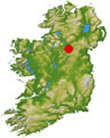Slieve Russell Golf Course
Ballyconnell, County Cavan

Slieve Russell golf club is a first rate course located in one of Ireland's least spoiled and less well known regions. The golf course is part of the 4**** Slieve Russell Hotel Golf and Country Club, designed specifically to be a haven of peace and tranquility yet less than 2 hours from both Dublin and Belfast. The course is built in a drumlin covered valley and the naturally undulating fairways reflect this. Mature trees abound and there are significant water-features on 5 holes, including three consecutively at the start of the inward half ending with a trip around Lough Rud.
Slieve Russell Course Description
The golf course is in keeping with the splendid peace and tranquility of Slieve Russell but is nevertheless of sufficiently high quality to have hosted a European Tour event - the Northwest of Ireland Open was played here in 2000 and Slieve Russell also hosted the Irish Professionals Championship in 2002.
From the outset, the course works its way gently downhill, where at the 434-yard second, which bends to the left, there is an increased chance of carrying the dogleg, guarded by three spacious fairway bunkers. Strong tee shots will find the short grass between these bunkers and a stream, which will be carried on the uphill approach. Clearly one of the better tests at Slieve Russell, strength and strategy must be exercised. A smart line must be chosen from the tee, and a solid long iron is necessary to find the elevated green.
Thereafter, the course continues to climb, and from the fourth tee the pastoral beauty of the property is in panoramic view. At just 167 yards, the task at hand seems a modest one, but the hole is tricky, featuring contours that can disturb depth perception and a green that subtly runs away from the golfer. The massive valley beyond the green makes it difficult to gauge the accurate distance from the elevated tee, and bunkers looming to the left and short do not allow for a mishit.
The other short hole on the seventh need not resort to these clever and delicate challenges. Arguably the most stunning hole on the course, the 220-yard shot is played from a highly elevated tee, so long irons and fairway woods are likely to hold the green if it is found. Nevertheless, a ring of four bunkers will snare near-misses, and the vista, or a moment of pause for a photograph, can be a undesirable distraction. The miss here is short, where a narrow opening allows the golfer the ability to run their longer club in. The entire property is within site from the tee, including the distant hills and the hotel, so the camera opportunity can be very enticing.
It is towards that clubhouse that the concluding holes on the front side climbs, and from the height of elevation, the course again drops into a valley to begin the back side, with the most dramatic descent coming at the 193-yard 11th. Playing to a green fronted by a pond and stone retaining wall, but averting the water is not the definitive measure of success. Front bunkers will catch many good shots, so only good shotmaking combined with a dose of good fortune will yield a birdie chance.
The longest par four on the card comes at 15, a 453-yard test that plays longer for the shorter hitter. A slope in the fairway is easily caught by longer hitters, while a modest play from the tee will leave a fairway wood from a plateau. The lone consolation is a thin neck of fairway flanked by greenside bunkers, allowing long second shots to run onto the front edge.
The charming aesthetics of fountains and waterfalls belie the challenges on 16, but at the 540-yard 18th, there is no such distraction. Inching uphill all the way towards the hotel and clubhouse, two large fairway bunkers are the most imposing feature, choking the fairway in the final 100 yards. A good lay-up is crucial here, setting up an uphill wedge that must find the right shelf on the green.







